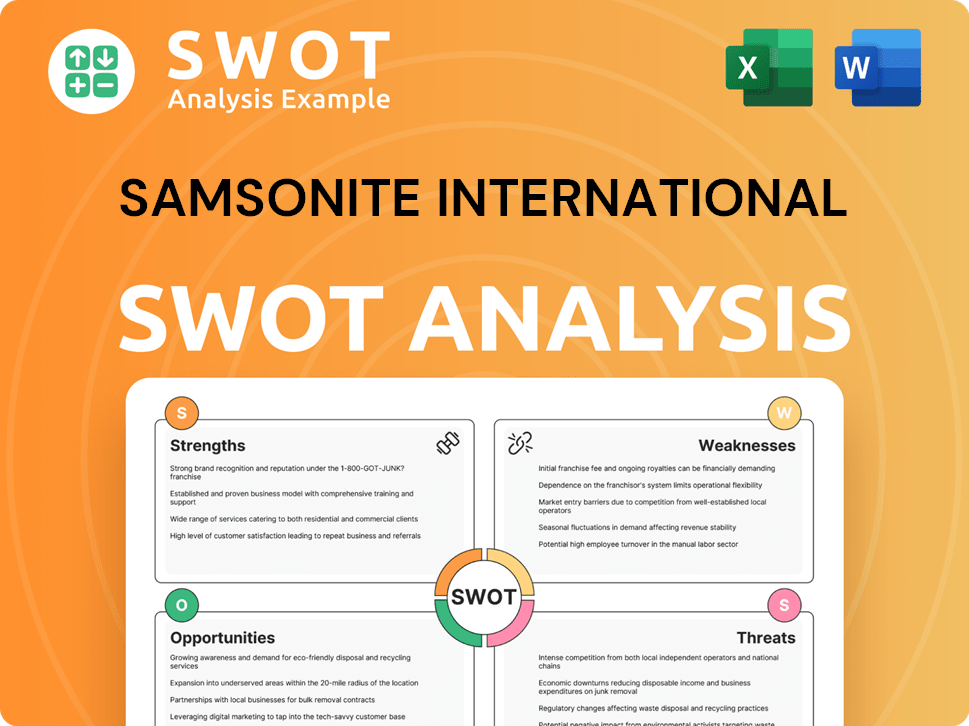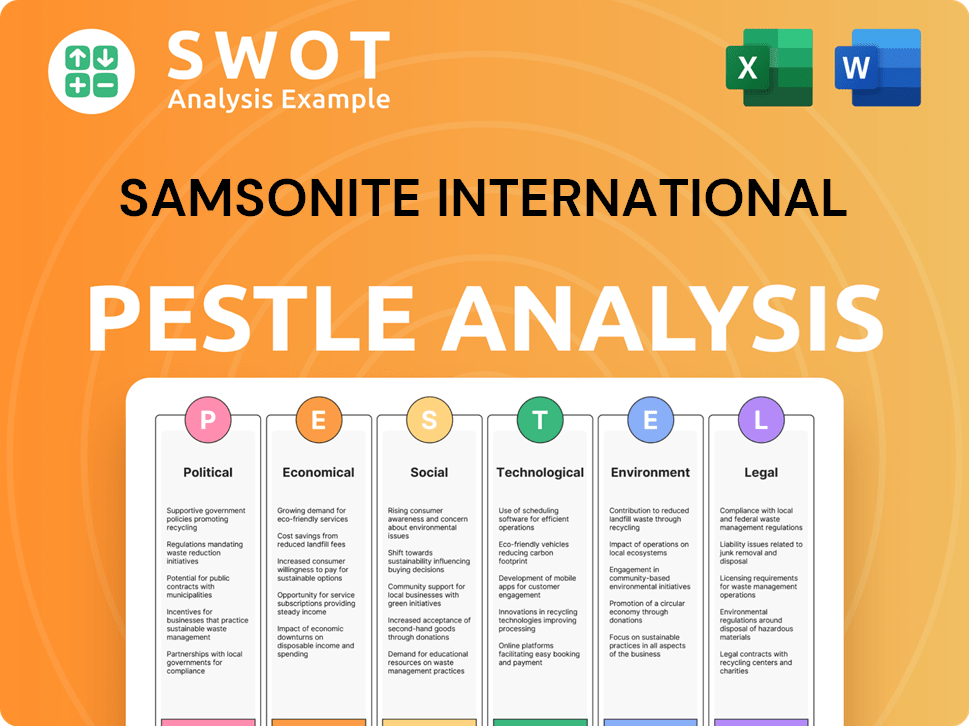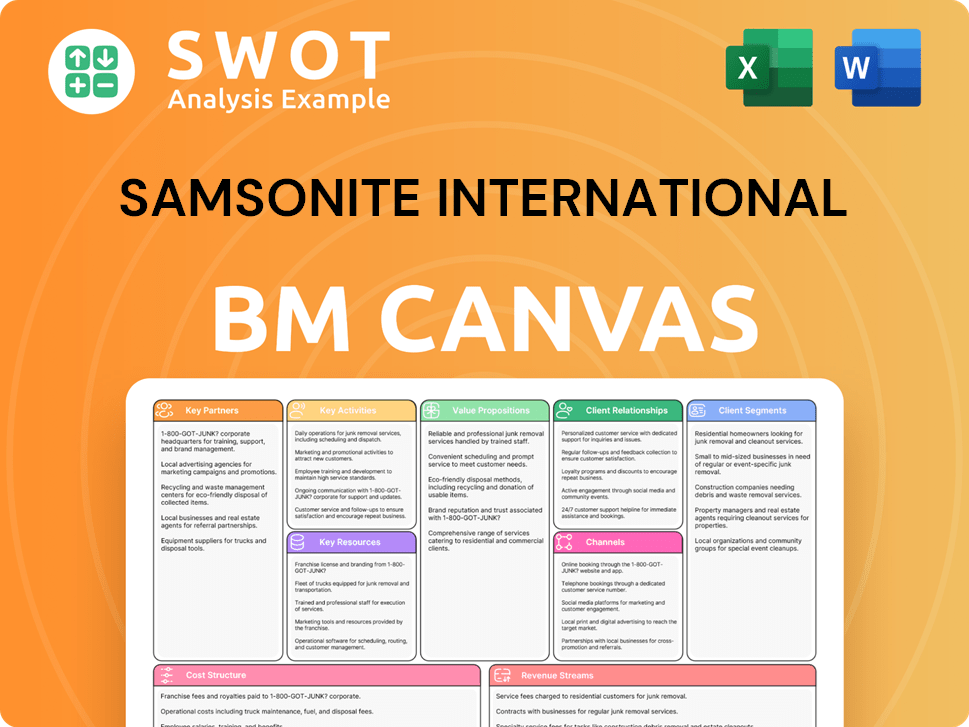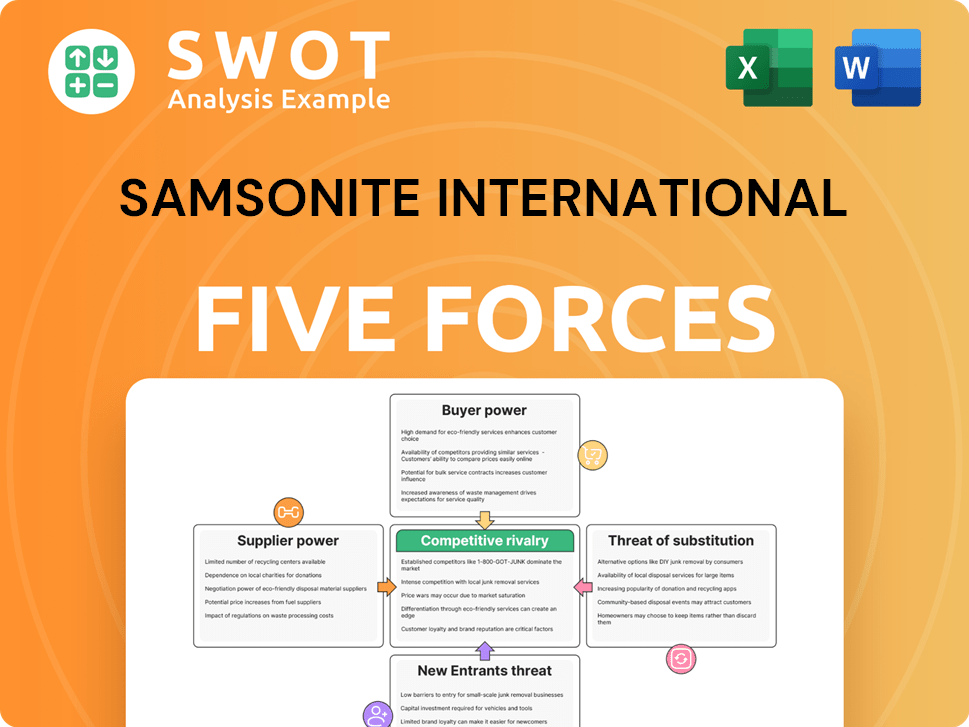Samsonite International Bundle
What Drives Samsonite International's Success?
Understanding a company's core principles is crucial for assessing its potential. Samsonite, a global leader in luggage and travel accessories, has built a legacy on its clearly defined mission, vision, and core values. These elements are the bedrock of its strategic decisions and brand identity.

Delving into the Samsonite International SWOT Analysis reveals how these guiding principles translate into tangible business strategies and market success. Examining the company's mission, vision, and core values provides valuable insights into its long-term goals and commitment to stakeholders. Explore how Samsonite's dedication to its mission, vision, and values shapes its operations, influences its corporate culture, and drives its pursuit of excellence in the competitive travel industry.
Key Takeaways
- Samsonite's mission centers on enabling journeys, while its vision targets a sustainable future.
- Durability, innovation, and a multi-brand approach are key strengths for Samsonite.
- Sustainability is increasingly vital for Samsonite's product development and market strategies.
- Alignment with core principles is crucial for adapting to market changes and consumer expectations.
- Samsonite aims to lead the travel goods industry towards greater environmental responsibility.
Mission: What is Samsonite International Mission Statement?
Samsonite's mission is 'To empower a lifetime of journeys that move the world forward.'
Let's delve into the heart of Samsonite's purpose. Understanding the Mission, Vision & Core Values of Samsonite International is crucial for grasping the company's strategic direction and its impact on the travel industry and beyond. This mission statement goes beyond simply selling luggage; it's about facilitating experiences and contributing to global progress.
At its core, the Samsonite mission focuses on enabling and enhancing the travel experiences of individuals worldwide. This is achieved by providing high-quality, durable, and innovative travel solutions. The company understands that travel is about more than just getting from point A to point B; it's about the journey itself and the memories created.
The mission also emphasizes Samsonite's contribution to global progress. This is achieved by supporting the movement of people, goods, and ideas across the world. By providing reliable travel gear, Samsonite facilitates exploration, business, and cultural exchange, thereby fostering a more interconnected world.
Samsonite's target customers are diverse, encompassing global travelers across various segments. To cater to these varied needs, the company employs a multi-brand strategy. This includes the flagship brand Samsonite, alongside premium brands like Tumi, and value-oriented brands such as American Tourister, allowing Samsonite to address a broad spectrum of travelers.
Central to the Samsonite mission statement analysis is its commitment to quality, durability, and design. Their products are engineered to withstand the rigors of travel while offering stylish and functional designs. This focus ensures customer satisfaction and brand loyalty, crucial for long-term success in the competitive travel market.
An increasingly important aspect of the Samsonite mission is its commitment to sustainability. The company is actively integrating sustainable practices into its operations, from product design to manufacturing processes. This includes using recycled materials and reducing its environmental footprint. In 2024, approximately 40% of net sales came from products with recycled content, demonstrating a strong commitment to environmental responsibility.
Samsonite's mission is supported by significant investments in research and development. In 2023, the company invested approximately $30 million in R&D to drive product innovation and sustainability initiatives. This commitment ensures that Samsonite remains at the forefront of the travel industry, continuously improving its products and processes.
In summary, the Samsonite mission is a customer-centric, forward-thinking statement that guides the company's operations and strategic decisions. It emphasizes enhancing travel experiences, contributing to global progress, and embracing sustainability. This mission, coupled with its core values, shapes Samsonite's identity and its role in the world.
Samsonite International SWOT Analysis
- Complete SWOT Breakdown
- Fully Customizable
- Editable in Excel & Word
- Professional Formatting
- Investor-Ready Format

Vision: What is Samsonite International Vision Statement?
Samsonite's vision is 'to use our leadership position to create a path towards a more sustainable future for our industry.'
The Samsonite vision statement is a forward-looking declaration, setting an ambitious course for the company. It's a clear articulation of Samsonite's vision, emphasizing the company's commitment to environmental stewardship and industry leadership. This vision goes beyond mere business objectives; it aims to reshape the entire travel and lifestyle bag sector.
The scope of Samsonite's vision extends beyond its own operations, aiming to influence the entire travel and lifestyle bag sector. This broader perspective highlights Samsonite's aspiration to be a catalyst for change, encouraging other companies to adopt more sustainable practices.
The vision is underpinned by concrete sustainability goals. These include achieving 100% renewable electricity in its own operations and significantly increasing the use of recycled materials. These are key elements of Samsonite's goals for environmental responsibility.
Samsonite has already demonstrated its commitment by achieving 100% renewable electricity in its owned and operated facilities in 2023, ahead of its 2025 target. This early success showcases the company's dedication to its vision.
A crucial part of Samsonite's vision involves increasing the use of recycled materials. The company aims to reduce Scope 3 emissions from purchased goods and services by 52% by 2030, demonstrating a tangible commitment to circular economy principles.
Given Samsonite's current trajectory, its vision appears both realistic and aspirational. The company's progress in renewable energy and recycled content suggests that its sustainability goals are achievable, yet still challenging.
The progress made towards its sustainability goals makes the vision credible. The company's actions, such as the use of recycled materials in a notable percentage of its sales, demonstrate a tangible commitment to its long-term vision. Further insights into the company's strategic direction can be found by exploring the Owners & Shareholders of Samsonite International.
Samsonite's vision for the future is a powerful statement of intent, driving the company towards a more sustainable and responsible business model. The emphasis on industry-wide influence, combined with concrete sustainability goals, positions Samsonite as a leader in the travel and lifestyle bag sector, demonstrating how Samsonite's mission and Samsonite's core values are aligned with its long-term strategy.
Samsonite International PESTLE Analysis
- Covers All 6 PESTLE Categories
- No Research Needed – Save Hours of Work
- Built by Experts, Trusted by Consultants
- Instant Download, Ready to Use
- 100% Editable, Fully Customizable

Values: What is Samsonite International Core Values Statement?
Understanding the core values of Samsonite International Company is crucial to grasping its identity and strategic direction. These values are the guiding principles that shape its operations, influence its interactions, and define its brand.
Durability and quality are fundamental to Samsonite's heritage. This commitment is evident in their rigorous testing processes and the selection of resilient materials, ensuring products that withstand the rigors of travel. This focus builds trust with customers, reinforcing the brand's reputation for reliable travel gear.
Innovation has always been a driving force for Samsonite, fueling the development of new features, materials, and technologies. This commitment is reflected in the continuous evolution of their product lines, integrating advanced technologies and exploring sustainable materials to enhance the traveler's experience. For example, recent innovations include the use of recycled materials in luggage production, showcasing their dedication to sustainability.
Sustainability is increasingly central to Samsonite's operations. The company is actively reducing its environmental impact, increasing the use of recycled content in its products, and striving for carbon neutrality. This commitment positions Samsonite as a leader in responsible manufacturing within the luggage industry, differentiating it from competitors.
Samsonite prioritizes understanding and meeting the needs of its diverse customer base. This value shapes product design, marketing strategies, and the development of a multi-brand portfolio catering to different segments. Efforts to enhance customer service and the overall consumer experience are constantly being made. This customer-centric approach helps Samsonite maintain its market position and adapt to evolving consumer preferences.
These Samsonite core values of durability, innovation, sustainability, and customer centricity collectively define the company's identity. These values are essential to understanding how Samsonite achieves its goals and how it plans to maintain its position in the global market. Next, we will explore how the Samsonite mission and vision influence the company's strategic decisions.
How Mission & Vision Influence Samsonite International Business?
Samsonite's mission and vision statements are not merely aspirational; they are the cornerstones of its strategic framework, significantly influencing the company's direction and operational decisions. These statements guide the allocation of resources, the development of new products, and the expansion into new markets, ensuring a cohesive and focused approach to achieving its objectives.
The Samsonite mission to "empower journeys" and its Samsonite vision for a sustainable future are directly reflected in its strategic initiatives. This alignment ensures that every business decision contributes to the overarching goals of the company.
- Investment in Innovation and Sustainability: A $30 million investment in R&D in 2023 demonstrates a commitment to developing innovative products with increased recycled content, directly supporting both the mission and vision.
- Multi-Brand Strategy: The diverse brand portfolio caters to various customer segments, embodying the mission to empower a lifetime of journeys for diverse travelers.
- Expansion of Direct-to-Consumer Channels: The growth of e-commerce and physical stores enhances the customer experience and expands market reach. In 2024, Samsonite added a net of 67 company-operated retail stores, bringing their global network to 1,119 stores. E-commerce sales also saw a 5.8% increase in 2024, accounting for 11.4% of total sales.
- Sustainability Initiatives: Achieving 100% renewable electricity in its own operations and setting ambitious targets for reducing Scope 3 emissions are key steps towards realizing the vision of a sustainable future.
The Samsonite company consistently focuses on innovation, aligning with its mission to empower journeys. This is evident in the development of new products that incorporate advanced materials and design features, enhancing the travel experience for consumers.
Enhancing the customer experience is a key priority, driven by the mission to empower journeys. The expansion of direct-to-consumer channels, including e-commerce and physical stores, demonstrates the company's commitment to reaching customers where they are.
The Samsonite vision for a sustainable future is translating into measurable actions. This includes initiatives aimed at reducing the environmental impact of its operations and products, such as using renewable energy and reducing emissions.
Although specific quotes linking every decision to the mission and vision may not always be available, the company's leadership, including CEO Kyle Gendreau, consistently emphasizes the importance of innovation and sustainability as part of the strategic direction, solidifying the link between the Samsonite values and business practices.
The financial performance of Samsonite is directly influenced by its strategic investments, which are guided by its mission and vision. The $30 million investment in R&D in 2023, for example, is a direct result of the company's commitment to its Samsonite goals of innovation and sustainability.
The multi-brand strategy of Samsonite is a direct reflection of its mission to empower a lifetime of journeys for diverse travelers. This approach allows the company to cater to a wide range of customer segments, ensuring that it can meet the needs of travelers with different preferences and budgets.
In conclusion, the Samsonite mission and Samsonite vision are integral to its strategic decision-making process. They guide the company's investments, product development, and market strategies, ensuring a cohesive and focused approach to achieving its goals. For a deeper understanding of how Samsonite implements its strategies, read more about the Marketing Strategy of Samsonite International. Next, we'll delve into the core improvements to the company's mission and vision.
Samsonite International Business Model Canvas
- Complete 9-Block Business Model Canvas
- Effortlessly Communicate Your Business Strategy
- Investor-Ready BMC Format
- 100% Editable and Customizable
- Clear and Structured Layout

What Are Mission & Vision Improvements?
While Samsonite's current Samsonite mission and Samsonite vision provide a solid foundation, there are opportunities to refine them to better reflect evolving consumer expectations and industry best practices. These improvements would further solidify Samsonite's position as a leader in the travel and luggage industry.
Integrating a stronger element of social responsibility into the Samsonite mission or Samsonite vision could amplify the company's commitment to ethical sourcing and community impact. This could involve explicitly mentioning initiatives related to fair labor practices, supplier diversity, or expanded partnerships with non-profits, building upon their existing Samsonite values of global responsibility. According to a 2024 report, consumer demand for socially responsible brands has increased by 15% in the last year, making this a crucial area for growth.
Explicitly addressing the circular economy within the core statements would underscore Samsonite's commitment to sustainability and resource efficiency. This could involve highlighting their goals for increased recycled content, product durability, and exploring innovative models like repair and recycling programs. In 2023, Samsonite increased the use of recycled materials in its products by 20%, and a more explicit focus on circularity could further accelerate this trend, aligning with the growing consumer preference for sustainable products. This is in line with the Brief History of Samsonite International.
As technology continues to reshape consumer behavior and the travel experience, the Samsonite mission and Samsonite vision could benefit from explicitly acknowledging the role of digital innovation. This could involve emphasizing the use of technology to enhance the customer journey, personalize travel experiences, and create more sustainable products and services. The global travel technology market is projected to reach $20 billion by 2026, making it essential for Samsonite to integrate digital strategies into its core mission.
While Samsonite's existing statements focus on empowering journeys, refining this to highlight the benefits of travel in a changing world would be beneficial. This could include referencing the role of travel in promoting cultural understanding, personal growth, and connecting people, especially in a post-pandemic world. With global travel expected to reach pre-pandemic levels by late 2024, emphasizing these benefits could resonate strongly with consumers and reinforce the Samsonite goals.
How Does Samsonite International Implement Corporate Strategy?
Implementing a company's mission, vision, and core values is crucial for translating strategic intent into tangible actions and outcomes. This section examines how Samsonite International Company operationalizes its stated principles across its business practices.
Samsonite's 'Our Responsible Journey' initiative, launched in 2020, serves as a primary vehicle for implementing its Samsonite vision of a sustainable future. This strategy is built upon three key pillars: Product, Planet, and People, each encompassing specific goals and initiatives.
- Product: Focuses on sustainable product innovation, including the use of recycled materials and reducing environmental impact.
- Planet: Addresses climate change through initiatives like renewable energy adoption and reducing carbon emissions.
- People: Prioritizes employee well-being, diversity, and inclusion.
- Governance: Provides a framework for accountability and transparency.
Leadership plays a critical role in reinforcing Samsonite's mission and vision. CEO Kyle Gendreau actively communicates the importance of sustainability and innovation, ensuring these principles are integrated into the company's strategic direction. This top-down approach helps to embed the values throughout the organization.
Samsonite utilizes various channels to communicate its mission, vision, and values to stakeholders. Investor relations materials, sustainability reports, and internal communications are key tools. The recent name change to Samsonite Group S.A. reflects the company's evolution and focus on customer-centricity, as well as the importance of its iconic brands.
Concrete examples demonstrate the alignment between Samsonite's core values and its business practices. Investments in R&D for sustainable product innovation are ongoing. The company has increased the use of recycled materials in its products, and achieved 100% renewable electricity in its owned operations. Samsonite also conducts a bi-annual Culture & Inclusion Survey, showing the company's commitment to diversity and inclusion.
Formal programs and systems are in place to ensure accountability and progress towards Samsonite's sustainability goals. The 'Our Responsible Journey' strategy provides a structured framework. The setting of science-based climate targets demonstrates a commitment to measurable environmental impact reduction. For example, the company aims to reduce its Scope 1 and 2 greenhouse gas emissions by a certain percentage by 2030. (Note: Specific percentage targets and dates should be verified with the latest available data from Samsonite's official reports, which are usually updated annually.) For more details, you can also read about the Growth Strategy of Samsonite International.
Samsonite International Porter's Five Forces Analysis
- Covers All 5 Competitive Forces in Detail
- Structured for Consultants, Students, and Founders
- 100% Editable in Microsoft Word & Excel
- Instant Digital Download – Use Immediately
- Compatible with Mac & PC – Fully Unlocked

Related Blogs
- What are Mission Vision & Core Values of Samsonite International Company?
- What is Competitive Landscape of Samsonite International Company?
- What is Growth Strategy and Future Prospects of Samsonite International Company?
- How Does Samsonite International Company Work?
- What is Sales and Marketing Strategy of Samsonite International Company?
- Who Owns Samsonite International Company?
- What is Customer Demographics and Target Market of Samsonite International Company?
Disclaimer
All information, articles, and product details provided on this website are for general informational and educational purposes only. We do not claim any ownership over, nor do we intend to infringe upon, any trademarks, copyrights, logos, brand names, or other intellectual property mentioned or depicted on this site. Such intellectual property remains the property of its respective owners, and any references here are made solely for identification or informational purposes, without implying any affiliation, endorsement, or partnership.
We make no representations or warranties, express or implied, regarding the accuracy, completeness, or suitability of any content or products presented. Nothing on this website should be construed as legal, tax, investment, financial, medical, or other professional advice. In addition, no part of this site—including articles or product references—constitutes a solicitation, recommendation, endorsement, advertisement, or offer to buy or sell any securities, franchises, or other financial instruments, particularly in jurisdictions where such activity would be unlawful.
All content is of a general nature and may not address the specific circumstances of any individual or entity. It is not a substitute for professional advice or services. Any actions you take based on the information provided here are strictly at your own risk. You accept full responsibility for any decisions or outcomes arising from your use of this website and agree to release us from any liability in connection with your use of, or reliance upon, the content or products found herein.